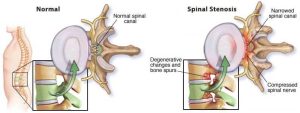The information provided on this website is intended for general informational purposes only. It does not constitute definitive treatment advice. For any questions or issues related to pain management, it is crucial to consult a medical professional. A thorough evaluation is essential for an accurate diagnosis and treatment plan.
×On This Page
 Cervical spinal stenosis is a narrowing of the spinal canal in its cervical part. This narrowing of the spinal canal, regardless of its cause, puts pressure in the spinal cords and nerves that originate from the spinal cord. Spinal stenosis, in general, is more common in the cervical and lumbar parts of the spine.
Cervical spinal stenosis is a narrowing of the spinal canal in its cervical part. This narrowing of the spinal canal, regardless of its cause, puts pressure in the spinal cords and nerves that originate from the spinal cord. Spinal stenosis, in general, is more common in the cervical and lumbar parts of the spine.
In most of the cases, spinal stenosis occurs when something reduces the normal space within the spine. However, some people are born with a narrow spinal canal. The most common causes of cervical spinal stenosis include:
While spinal stenosis can cause no signs and symptoms at all, others may experience severe signs and symptoms, affecting their daily life. The signs and symptoms of cervical spinal stenosis usually start gradually and intend to get worse over time. As mentioned, the signs and symptoms vary from one person to another, depending on its cause and the location of the stenosis. Characteristic signs and symptoms of cervical spinal stenosis include:
Sometimes it is difficult to diagnose cervical spinal stenosis, as its signs and symptoms resemble those of many medical conditions. However, imaging tests are necessary for the right diagnosis. These tests include:
Treatment usually depends on the cause of spinal stenosis, the severity of the signs and symptoms and its location. Some recommended medications to control the back pain that accompanies cervical spinal stenosis include NSAIDs, muscle relaxants, antidepressants, opioids, etc.
Physical exercise and therapy are also very important as they tend to strengthen the muscles of the neck, shoulders, and back, maintain the flexibility and stability of the spine as well as improving the balance.
Steroid injections including:
Are another treatment option, which tends to reduce the inflammation in the affected area, leading to relive of the nerve pressure.
Surgery is the last treatment option, in cases when all the other treatment options have failed to control the signs and symptoms of cervical spinal stenosis. The goal of surgical treatment procedures is to relieve the pressure on the spinal cord and nerves by enlarging the space within the spinal canal.
Pain Physicians NY (Brooklyn & NYC) provides a full range of advanced pain management services to help our patients return to a healthy and pain-free lifestyle. Our approach to pain care is individualized, and we providing the most effective treatments and utilizing the latest technologies available in the USA. The pace at which technology is growing can make last year’s methods obsolete. Our team is always at the top of their game and at the head of the pack.
We always consider non-invasive treatment options first before we turn to more invasive procedures like minimally invasive surgery.
Pain Management Brooklyn
2279 Coney Island Ave, Brooklyn, NY 11223
(718) 998 – 9890